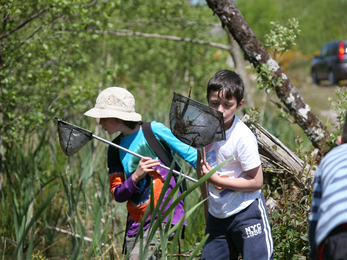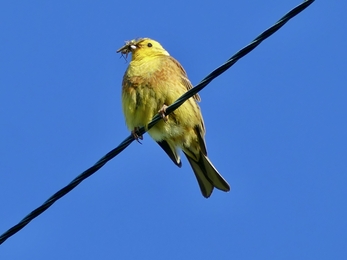
Photo, Nate Evans
Meeth Quarry
IMPORTANT NOTICE
Access to this Devon Wildlife Trust managed nature reserve/site
Please note that the gates to the nature reserve’s car park are locked each evening at 5pm and are not opened again until 9am. This does not affect pedestrian or cycle access to the nature reserve.
Know before you go
Dogs
When to visit
Opening times
The car park is open 9am to 5pm, Monday to SundayBest time to visit
All year roundAbout the reserve
A Devon Wildlife Trust nature reserve experience like no other – Meeth Quarry’s industrial past has produced a fascinating landscape for wildlife today.
Ash dieback
The disease ash dieback is now widespread in the UK and is present at many of our nature reserves, so we carry out tree felling across our sites in winter months. For your own safety please observe temporary path diversions and closures.
Where possible we will leave affected ash trees in place to decay naturally as an important habitat for wildlife. We plan to only fell diseased ash trees which pose a threat to people or infrastructure. Before trees are felled, we will check whether any rare or protected wildlife is present. If it is, we will postpone or avoid felling these trees. No felling will take place during the bird nesting season.
DWT’s Saving Devon’s Treescapes project are working with communities, landowners and businesses to help make Devon's precious treescapes more resilient in the face of ash dieback. Find out how you can get involved here.
NOTICE: If you are visiting our reserves, please note that there have been instances of H5N1 Avian bird flu found in birds in Devon. There is very low risk to public health, but we do ask that if you come across any unusual or unexplained bird deaths on or near our reserves, please do not touch them and avoid allowing your dog to come into contact with dead birds. Please report them to Defra here or call 03459 335577 and also report your findings to DWT by email at contactus@devonwildlifetrust.org.
Contact us
Location map
How to get to Meeth Quarry

A rich history
Until the late 1990s Meeth was a busy quarry producing clay for export.
At its peak, in the 1970s the quarry employed nearly 50 local people and produced 70,000 tonnes of clay per year. Much of this clay was used to make tiles, toilets, sinks and basins.
Anyone who recalls the nature reserve when Devon Wildlife first took it on in 2013 will have memories of the huge warehouses which stood overlooking the reserve’s car park and main entrance.
The ‘clay sheds’, as they were known, were on a gargantuan, cavernous scale. They suited the place in its former guise of Meeth the working quarry, when vast pits were dug by men and machines searching for the seams of clay that lay hidden in the earth.

Fox cubs. Photo, Neil Bygrave
New beginnings
Now that the clay sheds are finally gone it seems to signal the new beginning of Meeth’s next incarnation as a haven for wildlife and place for people to enjoy.
Nothing better seems to sum this up than the new wildlife watching hide which has risen on the banks of the nature reserve’s Stockleigh Lake – one of three large water bodies contained in this huge 150 hectare reserve.
But before reaching the hide there’s a lot of other features which are new. Ponds have been dug, ditches have been restored, hedges laid and new stock-proof fencing installed along Meeth’s grassland fields. Fencing doesn’t sound glamorous but it plays a vital role in allowing local reserve officer Ian Chadwick to control where and for how long Meeth’s small herd of Exmoor ponies are allowed to graze.
Their controlled nibbling is bringing colour back to the grasslands. In spring and summer fields that were dominated by the green of rushes now contain white, pink, blue and yellow from wildflowers including orchids, lady’s smock, knapweed and bird’sfoot trefoil.
The improvements brought about by Ian and his team of volunteers is bringing a wildlife return. Foxes and hares, newts and grass snakes, adders and common lizards, roe deer and wood white butterflies are some of the species found here.
Reaching the hideout
On reaching the wildlife hide, it’s immediately obvious that this is no ordinary wooden box. Most notable is its beautiful sedum ‘green roof’, the presence of which gives the hide a permanent feel, as if its already become part of the landscape.
From inside the hide the views are wonderful. The view drops away across the blue-grey water’s edge of one the reserve’s massive lakes. It’s the perfect place to see (and not be seen) by the local birdlife. On a ‘normal’ day you should hope little grebes, water rails, goosanders, tufted ducks and (lots!) of coots.
Stay for longer, and with a slice of luck, you could encounter a real rarity, such as the ospreys that have been known to stop off looking for a fish lunch in Meeth’s deepwater on their migration to and from the lochs of Scotland. Barn owls, peregrine falcons and merlins have also been seen around the reserve.
From the hide even massive water bodies of Meeth Quarry are beginning to look different from how they did at the beginning of Devon Wildlife Trust’s tenure in 2013. Their edges are softened with the hundreds of reeds planted by Ian and his team of volunteers. The look of a quarry is giving way to that of a lake.

Become a member and support our work
The vital work we do for nature depends on the support of people who care about the future of Devon’s wildlife and wild places.

The acquisition of Meeth Quarry nature reserve was made possible thanks to funding from Viridor Credits Environmental Company and generous individual donors.
The nature reserve's visitor facilities have been improved thanks to funding from Coastal Recycling.







